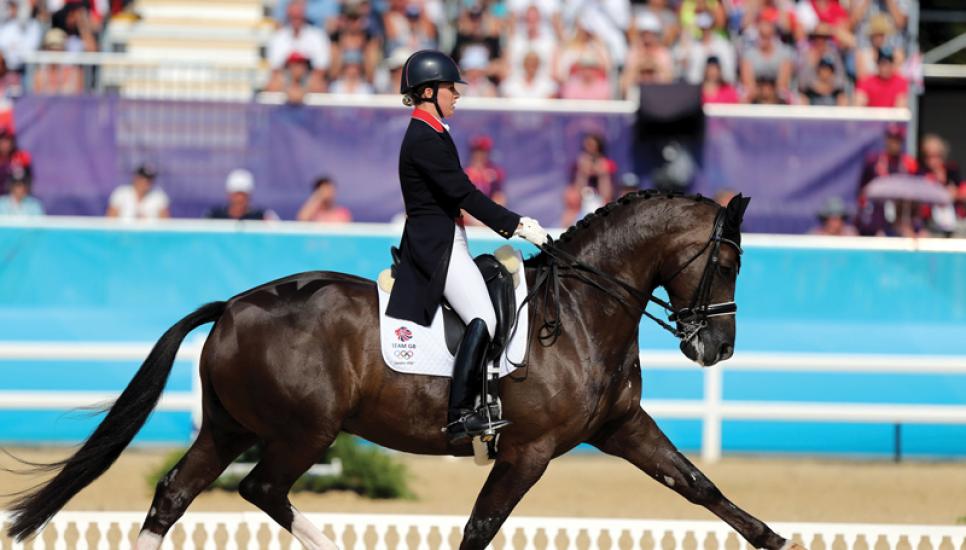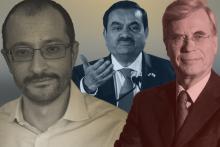On your high horse: behind the scenes of dressage

Those who followed Republican Mitt Romney's run for the 2012 US presidential elections will remember the multi-millionaire's bumbling attempts to connect with the working classes. So imagine the Democrats' glee when it emerged his wife was the co-owner of a million-dollar dressage horse, Rafalca, which was preparing to compete at the London Olympic Games. The couple, it emerged during the campaign trail, spent $77,000 (€61,300) annually on the German-bred mare – $50,000 more than the average US salary.
Dressage has a reputation for snobbery, which the sport as a whole has done little to try and shake off, and the association probably didn't win Romney any friends among blue-collar voters. While most sportsmen have abandoned the heavy, inhibitive kit of yesteryear in favour of a high-tech Lycra ensemble, dressage has clung resolutely to silk top hat and tails. Watching a couple of tonnes of horseflesh dance around an arena with its human counterpart dressed in Victorian garb is pretty baffling for the uninitiated, and might not seem the most obvious sport for the wealthy to throw their money behind, unless they have actually grown up around it.
However, with a couple of wonder horses currently taking the sport to new heights, dressage is attracting more and more newcomers. At the moment, the dressage hubs are mainly countries like Germany and Holland, the US and, to a lesser extent, Australia and New Zealand.
In Britain at least, the general public woke up to the sport post-Olympics, when three previously unknown athletes (six, if you count their mounts) added two medals to the host nation's gold rush. “After the Olympics people really started to stand up and take notice and realised the fun in it,” says Daniel Cook of Eclipse Equine Advisory – a UK-based company that sources and manages equine investments for the very wealthy across the world. These were Britain's first ever dressage medals, and the sums the owners were offered for the horses certainly made some alternative investors prick up their ears. It is rumoured that dressage enthusiasts in Germany and the Netherlands were offering up €12 million for bay gelding Valegro – the star of the British team – who, then at the age of 10, had approximately eight more years to his sporting career.
Racing is the obvious equine passion to spend on for anyone who strikes it rich: even if you know nothing about horses it is easy to understand – first one over the line wins – and a podium finish can reap millions. In dressage, riders are not competing for anything as louche as money. The largest purse is the European Championships at a little over €50,000. If you're looking for a return on investment it's going to come from your horse, rather than huge prize winnings.
“These high-end horses are high energy, they need tactful riding, they need good riding and sympathetic riding,” explains Carl Hester, gold medallist with the British team at the London 2012 Olympics and half owner of Valegro, as well as 13-year-old stallion Uthopia – another of the team's three horses. Years are put into teaching the horse the discipline's traditional movements and riders are often reluctant to let anyone else near their mounts in case one heavy-handed signal confuses the animal. Those in the sport agree a spectator needs some understanding of the work involved to appreciate it, making dressage the thinking person's equestrian sport.
For all its pomp and circumstance, however, dressage has lower barriers to entry than racing. A young horse with no training, even one with very high pedigree, can be acquired for relatively little, explains Winnie Murphy, spokeswoman for the British Dressage Association. “You start with a young gangly horse that can't really do anything and then you watch him grow and you watch him progress, and you may have only paid €3,000 for that gangly horse.” By the time the horse is six or seven and is showing his potential, an owner could get in excess of €30,000 if they decided to sell, even up to several million – as Valegro's owners found out.
Hester bought the German-bred horse amid a batch of two-year-olds, and admits the young animal didn't initially stand out from the crowd – so much so he even tried to sell him. When Hester couldn't find a buyer, he started training Valegro himself, only to discover his ugly duckling had a rare talent, and was seldom out of first and second place when he competed. As the young Valegro began to show his potential, Roly Luard, who grew up around horses and started buying top-class dressage horses around 15 years ago, got involved as a co-owner. She explains: “Valegro had actually failed the stallion grading test so he was gelded. [That] was a very interesting thing that people always zoom in on, because the stallion grading should have picked up a star and they didn't.” Luard bought a 50% stake in the horse – for an undisclosed sum – and has had the pleasure of watching him storm into the upper echelons of the sport.
Even a dressage horse without an Olympic gold medal could net a reasonable price if its owners want to sell. Unlike racing, there is a thriving amateur scene, where riders are often prepared to pay quite considerable sums for an animal trained by a professional. Compare this with racing, where a first-time buyer would have to splash big time to have a hope of ever seeing any silverware. “In the Middle East, the racing industry it's just booming at the moment,” explains Cook. “[Middle Eastern buyers] dominate buying up the quality stock, so it makes it tough because they are there and they're just outbidding each other and they're driving the prices up.” A well-bred one-year-old, not even old enough to have a rider on their back, would have once gone for €250,000 to €300,000, but today could fetch up to €800,000. If horse-loving millionaires in the Middle East were to catch the dressage bug the way the Brits have, it could well become a very expensive game to play.
Even in Europe though, horses can command significant prices. A few years ago, Schockemöhle Stud in Germany snatched Olympic gold medal hopeful Moorlands Totilas from the Dutch, for a rumoured price tag somewhere between €10 million and €25 million. The Dutch stallion's property magnate owner obviously saw dollar signs in the deal, but he was heavily criticised in local media for dashing the nation's Olympic medal expectations and selling up to one of the country's fiercest rivals. The sale provided two warnings for those considering buying into dressage: firstly, owning a country's medal hope brings with it a lot of responsibility. Secondly, it took Schockemöhle a long time to get similar results from Totilas that his Dutch rider had, and has only recently started bringing home any silverware for Germany. “Totilas proved you can spend as much money as you like but it's about partnership,” Hester says.
Unlike racing, the horse's rider will usually have a stake in the horse, giving them a bit more control. The most in-demand riders can afford to be particular as a result. “I tend to work with owners who are slightly horse orientated because they will understand the ups and downs of a career,” Hester explains. “Injuries, the fact that a horse's temperament might not be good enough for them to make it - there are all those factors involved.” The Romneys' annual bill for Rafalca, which didn't qualify for the medals round at London, shows this is not a sport for the working class. The owner will be spending thousands annually on the animal's upkeep, and the threat of injury destroying a horse's career always looms large.
But, if your four-legged athlete is a stallion, the moneymaking opportunities don't necessarily end at retirement. Schockemöhle Stud breeds up to 1,000 foals a year – since the resurrection of the Olympic Games in the early 20th century, Germany's and Holland's equestrian athletes, known as warmbloods, have earned reputations as reliable medal prospects. Around 150 of these will be sold as dressage horses – the rest are destined to be eventers or show jumpers. Selling artificial insemination via a top stallion is where the stud receives the remainder of its income, which at Schockemöhle averages €8,000 a pop. “Each stallion we have at the stud is only allowed to breed once it has been approved and licensed and not every stallion is allowed to breed,” explains Christoph Hinkle, breeding manager at the Schockemöhle Stud. An approved stallion can produce a couple of hundred offspring a year; a figure Valegro's owners perhaps cringe at.
Hester and Luard refuse to confirm whether the rumoured €12 million they were offered for Valegro is accurate, but they are now exploring a syndicated ownership option to unlock some of the gelding's value. Syndicates have been standard practice in racing and eventing for decades, but are almost unheard of in dressage until now. An investor gets a stake in Valegro, and also a slice of a young horse in the early stages of its training – as Luard puts it, you have the “elder statesman and the young pretender”.
Despite the possibility of a yearling growing into a multi-million dollar asset, money is rarely the reason individuals get involved in dressage. “If it's your horse that wins the British team a gold medal, then to watch that medal go round your rider's neck, there just can't be anything like it,” says Murphy. She insists the sport can appeal to newcomers, despite the fact dressage might not initially seem so straightforward. “Once a person got captivated by dressage then they would quickly learn, it's an enchanting sport, it's one that gets hold of you,” she says.
Dressage events also have pretty lavish corporate hospitality, and owners will often take advantage of these facilities to entertain guests and clients by treating them to an à la carte meal followed by ringside seats. The hype around Valegro has taken Luard to high places. She explains: “We've had amazing invitations, we've been to Clarence House for a drinks party with Camilla [Duchess of Cornwall], we've been to Olympic dinners, we've been to a garden party at Buckingham Palace, you're thoroughly spoilt. You weren't in the old days but you are now.”
But owning a living, breathing asset is also a commitment. Luard makes sure she is there to watch at every single event Valegro competes in, but admits she feels the pressure of owning a nation's medal hope sometimes. “I think 'Oh my goodness, he could be lame tomorrow',” she says, “I'm always thinking, 'What happens if something happens?' Everybody is going to be so heartbroken'.” She adds, “You're doing it because you're proud, you're doing something for your country, it's incredibly patriotic when you are actually there, you know everybody loves you for it.”
Finding a superstar horse is a once-in-a-lifetime event, and Hester now has two. As Hester explains, the yard breaks even, and winnings help cover costs, but his main income is from selling horses. With Valegro, however, he and Luard, despite the rumoured multi-million euro price tag, just weren't prepared to make the sale. Hester gave up daydreams of paying off his mortgage to hold on to the pleasure and excitement of being one of Valegro's owners. “The horse has won five gold medals and has just won the cup final, we've been offered life-changing sums of money,” he says, “but at the end of the day, I am also a horse lover and a human being. I just couldn't do it.”






